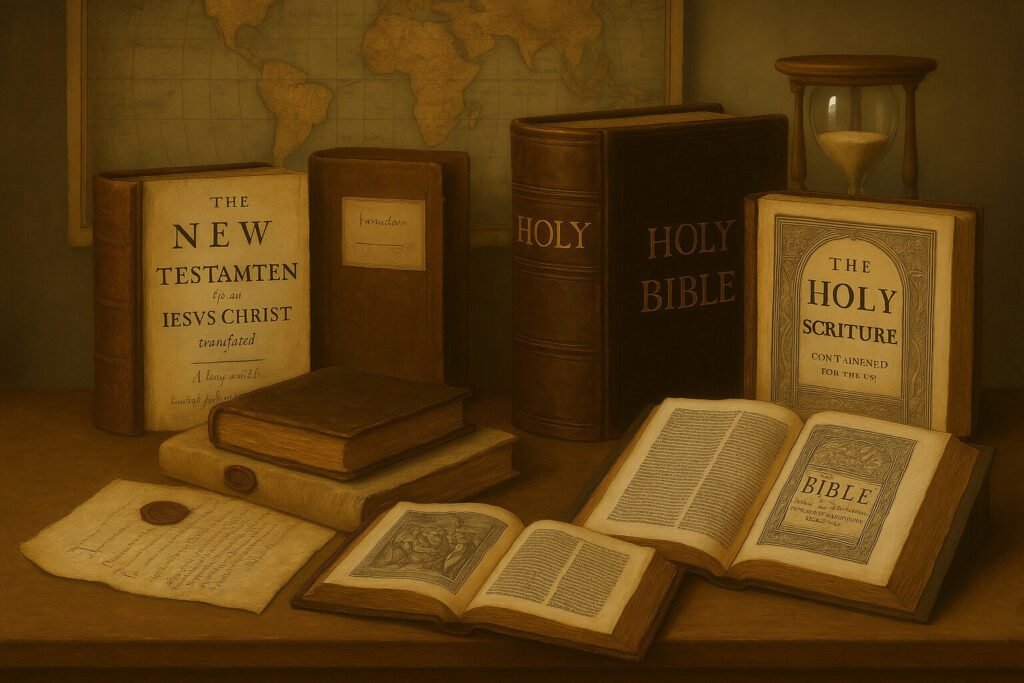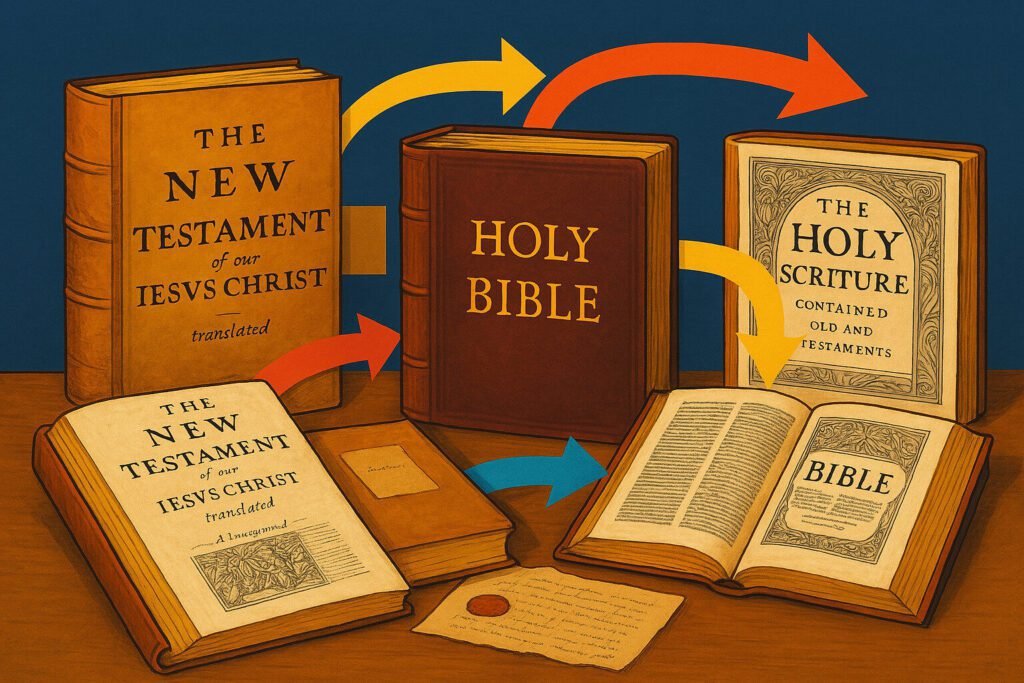Charting an Antiquarian Bible collection that reflects the unfolding story of Scripture invites both scholarly depth and personal passion. By focusing on editions that marked turning points, weaving a coherent narrative, and tracing links between printings, you’ll cultivate a library that’s as instructive as it is inspiring.
The journey through Bible history is enriched significantly by a number of key editions that have left an indelible mark on not only religious thought but also on the evolution of literature and societal values.
Key Editions That Changed History
- The Septuagint, a Greek translation of the Hebrew Scriptures (c. 3BC): The Septuagint significantly influenced the vocabulary and language of the New Testament writers.
The Septuagint represents a critical edition in the annals of Bible history. Its significance cannot be overstated, as it became the version of the Old Testament most widely used by early Christians. The Septuagint facilitated cross-cultural exchanges between Jewish and Greek traditions and played a crucial role in the formulation of early Christian theology. For collectors, possessing a copy of such biblically significant editions provides not only historical context but also a tangible connection to the roots and development of biblical texts.
- Gutenberg Bible (c. 1455) The first major book printed using movable metal type in Mainz, this landmark edition revolutionized text dissemination and kicked off the print era.
One of the foremost editions is the Gutenberg Bible, printed in the 1450s, which is often heralded as the first major book produced using movable type. This pioneering endeavor not only democratized access to the Scriptures but also catalyzed the spread of literacy and learning throughout Europe, fundamentally altering the landscape of biblical scholarship and ecclesiastical authority.
- Tyndale New Testament (1526) William Tyndale’s translation was the first English New Testament printed, laying the groundwork for future English Bibles.
The Tyndale New Testament of 1526 was a groundbreaking achievement. William Tyndale, a scholar and reformer, produced this work based on the original Greek and Hebrew texts, rather than the Latin Vulgate, a departure from the established practice. His translation was driven by the belief that ordinary people should have access to the Scriptures in their own language. However, this challenged the authority of the Church and State, which sought to control access and interpretation of the Bible, leading to it being banned and copies being publicly burned. Tyndale’s unwavering commitment eventually led to his martyrdom, yet his simple and direct language profoundly impacted subsequent English translations, including the King James Version, and left an indelible mark on the English language itself.

- Coverdale Bible (1535) The first complete printed English Bible, drawing heavily on Tyndale’s New Testament and Matthew’s translation of the Pentateuch.
The Coverdale Bible, published in 1535, was a significant milestone as the first complete printed English Bible. Compiled by Miles Coverdale, it built upon William Tyndale’s earlier translation of the New Testament and parts of the Old Testament. Coverdale aimed to make the Scriptures accessible to common people, and his work facilitated this goal by utilizing Tyndale’s groundbreaking efforts and incorporating other Latin and German translations to complete the Old Testament. While the 1535 edition was not officially authorized, it played a key role in the subsequent development of English Bibles, influencing later translations. The Coverdale Bible’s legacy is found in its contribution to making the Bible available in English and shaping the language of future translations.
- Geneva Bible (1560) Introduced verse numbering and extensive margins, becoming the most popular personal Bible of its day.
The Geneva Bible, first published in 1560, improved Bible accessibility and study for English speakers. Translated by English Protestant scholars in Geneva during the reign of Queen Mary I, (“Bloody Mary”), this version was the first English Bible divided into chapters and numbered verses, which improved navigation and referencing. The Geneva Bible was also the first English study Bible, including marginal notes, commentaries, and cross-references to aid understanding. These annotations were highly valued and contributed to the Geneva Bible’s popularity, even for personal use. Its popularity and theological notes led King James I to commission the King James Version, seeking a version without the notes he considered “seditious”. Despite this, the Geneva Bible influenced William Shakespeare, John Bunyan, and the early Pilgrims in America, and contributed to later English Bible translations.
- King James Version (1611) Commissioned to unify the Church of England, the KJV’s majestic language shaped English-speaking Christianity for centuries. Early first editions and issue variants remain prized among collectors.
A pivotal edition is the King James Version (KJV), commissioned in 1604 and published in 1611. The KJV played a transformative role in the English-speaking world, serving not just as a translation but as a literary masterpiece. Its poetic cadence and memorable phrasing influenced various aspects of Western culture, inspiring countless works of literature and art. Collectors of historical Bible collections often regard the KJV as a cornerstone, due to its wide-reaching impact on language, theology, and societal norms.
Incorporating these influential editions into a historical Bible collection can serve as a solid foundation and illuminate the myriad ways in which these texts have shaped faith and culture over centuries.
Creating a Collection with Historical Narrative
To create a cohesive collection, collectors should first focus on identifying recurring themes across various biblically significant editions. For instance, examining the evolution of translations can unveil how language shifts reflect societal changes and theological developments.

The historical contexts surrounding biblical interpretation also play a crucial role in shaping a collection. The impact of significant events, such as the Reformation or the Enlightenment, on how the Bible was read and understood can inform collectors on the relevance of specific texts. Exploring different periods can offer a rich perspective on how biblical narratives have been interpreted differently over time, which is essential in adding depth to one’s collection. Moreover, understanding these contexts allows collectors to appreciate the transformative power of scripture and its adaptability to diverse cultural settings.
By synthesizing historical narratives with each acquisition, collectors can create a Bible collection that not only preserves history but also tells a powerful story of faith, interpretation, and community across the ages.
Finding Historical Connections Between Editions

One of the effective methods for tracing the origins of certain translations is through the use of digital archives. Numerous libraries and institutions now offer online access to historical manuscripts, allowing collectors to view ancient texts that have shaped Bible history. These archives may include digitized versions of early printed Bibles, manuscripts, and related documents that shed light on the historical significance of particular editions. By comparing different translations, collectors can discern how biblical interpretations have transformed over centuries, depending on theological, political, and cultural influences.
Understanding the historical context in which specific editions were produced is crucial. For instance, the Great Bible of 1539 holds particular significance due to its endorsement by King Henry VIII, which reflects the political influences of the time. By delving into the motivations behind the creation of various historical editions, collectors not only enhance their knowledge of Bible history but also uncover fascinating narratives associated with those texts. Ultimately, being aware of these connections will aid in assessing the value and significance of each piece within a broader narrative of biblical translation and reception.
Uncovering historical connections between various Bible editions is an essential step in building a comprehensive historical Bible collection. The process begins with researching the lineage of the texts, which can reveal how certain translations have evolved over time and their significance in biblical scholarship. To embark on this journey, collectors should familiarize themselves with foundational bibliographical sources. These resources often contain valuable information about the publication history, authorship, and the sociocultural contexts surrounding various biblically significant editions.
Unearthing links among your volumes deepens appreciation and scholarly value:
| Edition | Year | Connection |
|---|---|---|
| Tyndale New Testament | 1526 | First English NT; source text for Coverdale |
| Coverdale Bible | 1535 | Merged Tyndale & Matthew translations |
| Geneva Bible | 1560 | Built on Coverdale, added verse numbers and Reformed commentary |
| King James Version | 1611 | Drew from Tyndale, Coverdale, Geneva; standardized the English text |
Beyond texts, study:
Marginalia and annotations: Follow theological debates across editions via reader notes.
Printing technology: Compare typefaces, watermarks, and press marks.
Bindings and provenance: Track ownership inscriptions, binder’s stamps, or library markings.
Tips for Starting Your Historical Bible Collection
- First, identifying credible sources is essential. Prospective collectors should explore reputable online platforms that focus on biblically significant editions like BibleBulldog.com.
- Understand different printings, bindings, and even the paper quality used in various historical periods. Additionally, it is advisable to have a discerning eye for detail and to seek expert opinions, when necessary.
- Throughout this journey, the emphasis must remain on preserving the integrity and historical value of the collection, thus ensuring its significance for future generations.

